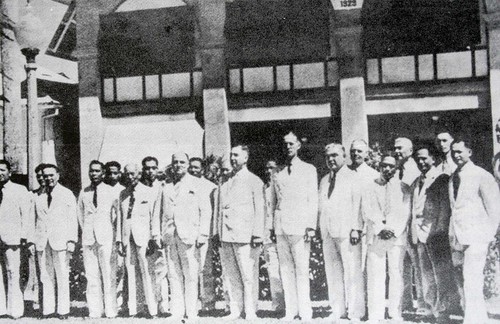Founder of Pedro’s
Pedro Pangelinan Martinez (1892 – 1967), also known as “Don Pedro,” was the founder of Pedro’s, a company that at one time included an ice plant, a cold storage, a mini-supermarket, a wholesale and retail business, a construction company, an automobile agency, and two large farms that provided beef and vegetables to the island. He was one of the island’s wealthiest and most respected businessmen in Guam during the US Naval period in Guam (1898-1941).
Martinez was the first to establish a manufacturing industry in Guam with the establishment of Pedro’s Ice Plant in 1921. The opening of the ice plant was an important event for the people of Guam, as very few owned electric refrigerators and most people had to preserve their food using “ice boxes,” which depended on daily deliveries of ice. Most people on island relied heavily on his ice plant for many years, and when the Japanese occupied Guam in 1941, his ice plant was one of the Japanese military’s most valuable seizures.
Martinez was born on 27 June 1892, and was educated in Guam, becoming a teacher at the age of 15 as was the custom for students who excelled. When he was 17, Martinez left Guam to earn a master’s degree in accounting at St. Mary’s College in North Carolina and, at the age of 20, a second master’s in accounting at Valparaiso University in Indiana. He also worked as a bookkeeper with the Caxton School Supply Company in Chicago in 1912.
Martinez returned to Guam in 1913 when he joined the US Navy Department as a civil service employee and was transferred to the island. He worked as a supervisor in the Naval government’s Pay and General Storekeeper’s Department for the next eight years.
In 1921, he went into business for himself, starting the well-known ice plant near the Tolai Acho (stone bridge) in Hagåtña. A year later he established the Chrysler Automobile Agency in 1922, selling Chrysler, Dodge, DeSoto, and Plymouth cars. In 1926, he went into the wholesale business and formed Pedro’s Construction Company, which built Guam’s first hotel, the Pan American Hotel in Sumay.
In the 1930s, his ice plant became extremely successful, as he expanded his delivery to the hospital, schools, government offices, the military, and hundreds of homes of island residents. He then expanded the business to include dairy products and opened a grocery market.
During the Japanese occupation, Martinez was one of several large farm owners who was forced to provide beef and farm produce to the occupying forces. He owned two large ranches, one in Dandan, Inalåhan, and another in Sasa, Piti, and he was one of the island’s biggest cattlemen, with more than 700 head of cattle. The farmers were given quotas based on the size of their farms, and Martinez was required to slaughter five head of cattle per week with no compensation.
Martinez was active in religious affairs and was appointed a “Knight Commander with Emblem of the Order of Pope St. Sylvester” by Pope John XXIII in 1959 because of his contributions to the church. He was one of the original members and president of the Guam Chamber of Commerce, the Young Men’s League of Guam, and the Guam Rotary Club.
Martinez served as director of the government-owned Bank of Guam, associate justice of the Court of Appeals, chairman of the Food Defense Council, and board member of the Guam Finance Development Agency, among other positions.
Martinez was married to Maria LG Torres, the great-niece of Padre Palomo y Torres, the first CHamoru priest. They were married for more than 50 years and had seven daughters and five sons, including the Rev. Vicente Martinez, who was at one time the pastor of the St. Anthony church in Tamuning.
Six years after his death, a statue of Martinez was erected in his honor at Pedro’s Plaza, also dedicated to his name. The statue now sits at Serena Park in Hagåtña.
For further reading
I Manfåyi: Who’s Who in Chamorro History. Vol. 2. The Hale’-ta Series. Hagåtña: Political Status Education and Coordinating Commission, 1997.





